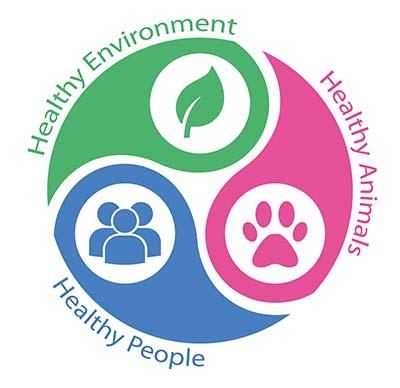

“If you want to learn about the health of a population, look at the air they breathe, the water they drink and the places they live.” – Hippocrates (c 460-370 BCE).
In recent years, the concept of One Health has emerged as an essential framework for addressing the interconnectedness of human, animal, and environmental health. The World Health Organisation defines One Health as an integrated approach aimed at sustainably balancing and optimising the health of people, animals, and ecosystems1. This concept emphasises the interdependence of human health with factors such as access to clean air, water, safe food, and medicines.
While the term "One Health" may be relatively new, its roots extend back centuries. Since the 1800s, scientists have recognised similarities in disease processes between animals and humans. However, it wasn't until the 20th century that the fields of human and animal medicine began to converge. Influential figures like Louis Pasteur and Calvin Schwabe were instrumental in establishing this movement, particularly in regard to recognising the interconnection between animal and human health.
Pasteur's groundbreaking research demonstrated the profound impact that diseases in animals can have on human health. In the case of dog-mediated rabies, it was crucial to combine both medical and veterinary medicine to develop an effective treatment. Pasteur was able to develop a rabies vaccine for dogs, which ultimately led to the creation of the first rabies vaccine for humans2. This achievement proved to be lifesaving for nine-year-old Joseph Meister, who had endured a staggering 14 bites from a rabid dog. This early recognition of the shared risks and benefits associated with disease control paved the way for the One Health approach.
Today, the importance of One Health is more relevant than ever, especially in the face of emerging infectious diseases, antimicrobial resistance (AMR), and climate change. To explore the practical applications of One Health and its implications in veterinary diagnostics and therapeutics usage, ��������ֱ�� hosted a panel featuring three experts from diverse disciplines within the One Health framework.
In this free CPD webinar, Helen Ballantyne (Chair of the UK One Health Coordination Group and multi-disciplined human and animal health nurse), Fergus Allerton (Veterinary surgeon and Linnaeus AMR lead), and Simon Doherty (past president of the British Veterinary Association) discuss the benefits and applications of One Health values across various settings. From human clinical care to veterinary antibiotic stewardship and livestock health, their insights promise to shed light on the critical intersection of human, animal, and environmental health. This article provides an overview of the webinar, along with valuable resources to empower you to take action.
From orchestrating life-saving transplant operations to navigating the complexities of patient discharge, each day in the healthcare profession can present a unique blend of challenges and opportunities. The concept of One Health mirrors this diversity, providing opportunities to navigate challenges with greater resilience and collaboration, ultimately paving the way for a healthier, more interconnected future.
While global health initiatives are essential for addressing widespread health challenges and improving overall well-being on an international scale, it's equally important to acknowledge the human-centred initiatives shaping daily experiences in healthcare settings. For example, Helen Ballantyne drew attention to the significance of the animal-human bond in healthcare.
While interactions with animals can present the risk of disease, humans also benefit enormously from interacting and bonding with companion animals. This bond is mutually beneficial and essential to the health and wellbeing of both animals and people. As such, there has been a growing movement for animal-assisted therapies, prompting innovative initiatives like sessions for NHS staff.
These programmes have been shown to enhance physical, social and emotional wellbeing, raise beneficial oxytocin levels, encourage clients out of emotional numbness, and significantly help in patients with mental illness3-7. Additionally, a survey conducted by the Royal College of Nursing (RCN) found that 90% of nurses believe that animals can improve the health of patients with mental health problems, and 60% said the presence of animals could speed patient recovery. However, many healthcare sites restrict the presence of animals due to the risk of infection.
Following from this, the RCN launched the first-ever nationwide 8, providing evidence-based best practice criteria so that hospitals and other health settings can integrate animal-based therapies in a safe and professional way. This protocol prioritises the wellbeing of the assistance animal, staff, and patients, deeming that dogs should be highly trained, used to a wide range of environments, in addition to being vaccinated and protected against fleas and parasites.
Beyond its tangible benefits, One Health holds profound implications for patient and staff well-being, empowering healthcare professionals to provide comprehensive care that transcends traditional boundaries. By fostering interdisciplinary collaborations and support networks, healthcare systems can better address the complex emotional needs of patients and staff alike, ensuring a more compassionate and integrated approach to care.
What can you do to highlight the importance of One Health in Small Animal Practice?
The antimicrobial crisis poses a significant threat to both animal and human health, with widespread implications for public health and veterinary medicine alike. In many cases, the overuse and misuse of antibiotics contributes to the development of antimicrobial resistance (AMR), rendering these life-saving drugs ineffective against bacterial infections. Fergus Allerton highlighted that this phenomenon transcends species boundaries, affecting both animals and humans and, as such, requires a collaborative One Health approach.
In veterinary medicine, the over prescription of antibiotics is a common concern, particularly in cases where evidence suggests that antibiotics may not always be necessary. For instance, in pets, less than 1% of acute diarrhoea cases require antibiotic treatment but data shows that approximately 50% of dogs with this symptom receive antibiotic prescriptions9,10. This is often driven by pet owner expectations and diagnostic uncertainty. This mirrors trends seen in human medicine, where antibiotics are frequently overused for upper respiratory tract infections and other minor ailments11.
To combat antibiotic over- or mis-use in veterinary practice, it is essential to prioritise judicious prescribing approaches, guided by evidence-based practices and a commitment to safeguarding animal and human health. Veterinarians can help mitigate the risk of AMR by educating pet owners about the importance of responsible antibiotic use, using diagnostic tools to prevent antibiotic misuse, and promoting alternative care measures, such as a managing symptoms, environment or diet.
Despite the challenges posed by the antimicrobial crisis, there are signs of progress on a global scale. A report from the World Organisation for Animal Health has announced a 13% reduction in antimicrobial usage globally, indicating positive strides toward addressing this pressing issue12. However, reducing the prescription of antibiotics is just one part of the solution.
A 2017 household survey in England revealed that, of almost 500 people who had received antibiotics in the previous 12 months, 14% had some leftover13. Of these, only 8% returned these unused antibiotics to a pharmacy for safe disposal, while two-thirds of patients either threw them away or kept them for use at a later date. Both of these choices pose serious risks, either contributing to increased AMR in the environment or inappropriate antibiotic use.
In November 2022, the veterinary sector teamed up with NHS Midlands to encourage the public to return out-of-date and unused antibiotics. The first was led by a collaboration of UK veterinary organisations, practices and charities to educate pet owners about AMR and raise awareness of the importance of the safe use and disposal of these important medicines.
The results were promising, with over 750 antibiotic tablets and various other products collected, including critically important antibiotics. By sharing knowledge, resources, and best practices, veterinarians and healthcare professionals can work together to combat antimicrobial resistance and ensure the continued effectiveness of antibiotics for future generations.
What can you do to highlight the importance of One Health?
As highlighted, the One Health initiative seeks to achieve optimal health and well-being outcomes for people, animals, plants, and their shared environment. However, Simon Doherty observed that despite its substantial impact and fragility, the ecological component is often overlooked, particularly when it comes to AMR15.
AMR is most commonly associated with antibiotic misuse by medical and veterinary practices, but this represents just one component of a much wider landscape. The AMR crisis involves a diverse network of contributing factors, including agricultural debris, pharmaceutical waste management, animal husbandry systems, residues and sewerage, and much more besides.
In light of the multifaceted challenge presented by AMR, initiatives to combat the crisis must engage diverse stakeholders, including agricultural engineers, disinfectant manufacturers, and ventilation experts, to develop holistic strategies and collaborative solutions for reducing antibiotic usage and minimise the occurrence of resistant bacteria.
Improving health and welfare in agricultural settings can yield positive benefits for both sustainability and productivity. For example, advancements in pro-active diagnostics, such as wearable devices and point-of-care tests, enable early detection and treatment of diseases, therefore reducing the need for antibiotics and anthelmintics. Similarly, innovations like robotic milking parlours and non-antimicrobial feed additives contribute to animal well-being while enhancing farm efficiency and reducing environmental impact. By investing in research and innovation, stakeholders across the agricultural sector can promote sustainable practices that benefit both animals and humans.
What can you do to highlight the importance of One Health?
The power of communication and collaboration across all facets of One Health cannot be underestimated and is the cornerstone of making progress. We can all make small changes that are individually important and will combine to impact on health, welfare and sustainability.
These small changes can contribute to the One Health movement - whether it’s related to day-to-day work, interactions with clients, through habits as a prescriber, or as a consumer. Many of the suggested actions from our expert speakers bulleted above are good starting points. What will your first action be?
Each of our speakers continue to extend their knowledge every day in an area which is constantly evolving. As we see more evidence of climate change, the effects of disease processes, or our impact on the world around us, the need for action at local and international levels increases.
As a global multidisciplinary company, ��������ֱ�� also contributes to many aspects of the One Health approach, enabling customers to undertake measurement and analyses in a broad variety of applications. It offers in vitromedical diagnostics, such as point-of-care analysers that support appropriate prescribing by differentiating viral and bacterial infections. In addition, ��������ֱ��’s instruments and solutions enable the analysis of air, water and compounds for automotive and industrial emissions testing, through to environmental monitoring and agricultural science. All of which can have current and future health implications for humans, animals and the environment.
The CPD webinar ‘One Health - Actions in diagnostics and therapeutics’ is available to watch here.